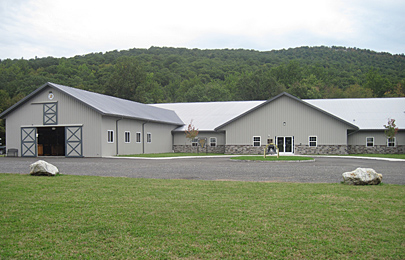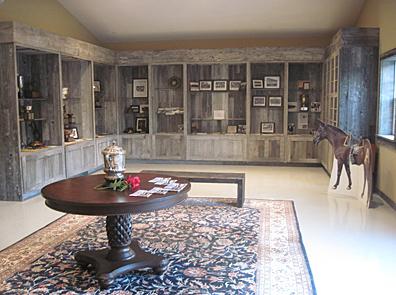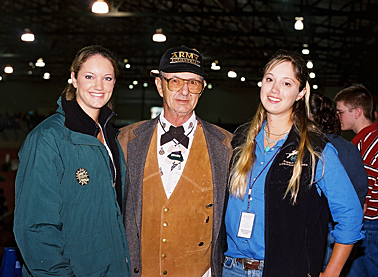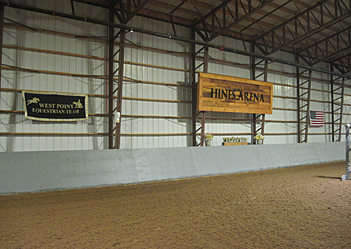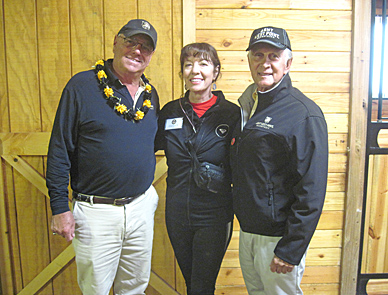|
||||||||
|
THE GENERAL CROSBIE E. SAINT EQUESTRIAN CENTER: AN INDOOR RIDING FACILITY OVER 40 YEARS IN THE MAKING The United States Military Academy has competed in IHSA competitions since at least the start of the 1970's if not during the first three years the organization used that name (1967-70). Yet riding at the USMA goes back much further than that, back to a time when horses, trains, boats and bicycles were the only modes of transportation. The USMA has been with us since 1802, the Bicycle was invented in 1817, the train started rolling on track in 1828 and horses, well, we will get back to you with a start date on that one. The USMA prioritized horsemanship perhaps from the time they opened their doors, and in 1846 the USMA constructed Thayer Hall, a building that was the largest indoor riding arena in the world at that time. Ulysses S. Grant just missed riding there as undergraduate (Grant graduated in 1843) but George S. Patton (class of 1909) would excel in equestrian pursuits and placed fifth in the Modern Pentathlon at the 1912 Olympics in Stockholm, Sweden. In 1958 Thayer Hall was converted into an academic building, and being so large today it houses the Departments of history, mathematical sciences, behavioral sciences and leadership, electrical engineering and computer science, and the academy's audio, visual and media support division. With the demise of Thayer Hall as an equestrian facility there was still someplace indoors on campus that could and would host equestrian events. Gillis Field House, best known today for the legendary Bobby Knight coaching the Army Basketball team there for six seasons and for USMA graduate Mike Krzyzewski playing for Knight there prior to becoming the head coach of both Army and Duke University (the latter where Krzyzewski has coached for 40 seasons), had a layer of dirt underneath the court which could be removed for events such as horse shows. IHSA Founder Emeritus Bob Cacchione often mentions the time George Morris judged a regular season IHSA show inside Gillis Field House sometime in 1975. It should be noted that Gillis Field House was a multi-purpose building, and events related to riding had to fit into a schedule around those of other sports and any other gathering arranged for the facility. However by the end of the 1970's alterations to Gillis Field House prevented the removal of the flooring and ended any hope of indoor riding at West Point for the forseeable future. The USMA's IHSA team was doing very well at the time. Coached by Col. Bob Balla, the USMA won the hunter seat Region Title in what is now Zone 3, Region 3 during the 1977-78 season (only the second year of co-education at the USMA). By the fall of 1979 all of the lessons and any events were held outdoors at nearby Morgan Farm in Highland Falls.
1982 USMA graduate Mike White recently related a story about one of the earliest attempts to get started on the next indoor riding facility on USMA property, which occured just before White was enrolled there. "Col. Balla said that a cadet left $200,000 to the USMA Equestrian Team to be used for construction of a new indoor equestrian facility. Col. Balla was upset that someone high up at the USMA decided that the donation could be used for any 'more pressing issue.' That issue was to install AstroTurf (what is more commonly called Artificial Turf) at Michie Stadium (Editor's Note: The AstroTurf was installed in time for the 1977 Football season, meaning interest in a facility beyond the occasional use of the field house was already underway)." For some time 'more pressing issues' continuted to halt the momentum of the creation of a new indoor facility at West Point. However in the 1990's things began to change. Peter Cashman, at that time and until very recently the Co-Head Coach of the USMA Equestrian Team with his wife Sherry, led the campaign to raise money for the construction of a new indoor facility, and unlike in the past Cashman's campaign gathered more and more momentum. As early as the late 1990's Cashman talked of building a 'bubble'-type indoor that would take up some of the space at Morgan Farm. At one point things looked gloomy but then in 2005 a sum was raised by selling a print by renowned artist Don Stivers entitled "No Shortcut to Greatness." Known for his support of the military, Stivers painted "No Shortcut to Greatness" depicting the West Point area shortly after the civil war (Ironically Stivers, who once gave the USMA class of 1961 over $20,000, served in the Navy during World War II). Once again the quest for a new facility was on the front burner.
Around the same time an individual involved with the formation of the IHSA passed away. Jerry Mupo, who coached Jersey City State's IHSA team at shows before the IHSA officially took on that name, was in his 80's. Mupo had a tremendous love of the USMA and rarely missed an IHSA show in which West Point was competing. Shortly after his passing Mupo's ashes were spread across Morgan Farm. "Jerry will be with us always," said Cashman at the time. But the Jerry Mupo story did not end there. Having earned a considerable amount of money as a bridge inspector for the state of New Jersey, Mupo wanted a sum given to the USMA specifically for the construction of a new indoor riding facility. Mupo stated in his will that the USMA had only a certain window of time to do this, and that the money could not be used for any other purpose. If the new indoor facility was not built in the specified time then all of it would go someplace else (White said that, for example, it might have gone to the Boy Scouts of America). It took a while to settle the Mupo estate, but when the dust settled the USMA had been given roughly $500,000 by Mupo and a date that would calculate out to 2019 or 2020 as the deadline to construct the building. Faced with losing such a large sum the academy went full speed ahead with fundraising. With the help of White and the West Point Association of Graduates a fundraising PDF surfaced on the internet in early 2017 showing a goal of $2,900,000, naming opportunies and the layout of the 30,500 square foot facility. A family named Roux purchased the Facility Naming Rights on behalf of General Crosbie E. Saint and his family. According to Cashman "General Saint served two tours in Vietnam. His commands included the 11th armored cavalry regiment, the seventh United States army training command first armored and the third cores of the United States Army Europe. He also served on the army science board and the advisory board for the Jewish institute for national security affairs. Saint was a 2012 recipient of the West Point Association of a grass distinguish cadet award." A member of the class of 1958, Saint passed away in 2018 at the age of 81. Other large donations came from a family named Anderson and a family named Lamb, the latter of which Mrs. Lamb competed on the 1982 USMA IHSA team.
The actual riding arena is named for Ronald O. Hines, USMA class of 1961. "Hines was the first Second Lieutenant from West Point to die in Vietnam," says Cashman. "He was a mule rider. The donation came from his college roomate." (Editor's Note: Hines would be happy to know that "Paladin" the Army Mule seen at every home football game is in a stall a few feet from Hines Arena). Though the original goal was 2.9 million the fundraising effort blew past that goal. "We raised 3.3 million in the last five years," says White. Needless to say the facility was constructed and would have opened a year earlier had covid-19 not erased the 2020-21 season for West Point. And in October of 2021 the Crosbie E. Saint Equestrian Center formally opened - twice! There was a party at the Equestrian Center on the evening of Friday, October 1st, attended by several former IHSA riders and dignitaries from West Point. Also in attendance was Michael O. Page, a 1964 Olympic Silver Medalist and a judge at many IHSA shows. Page donated a trophy to West Point for their museum, which is found in the middle of the building and serves as the main entrance or Grand Foyer. Many historic photos are on display in the museum, including one of Debra Lewis. Lewis and one of her teammates were the first females to join what had been an all-male roster (that could fill a point card) when the USMA went co-educational in 1976. Lewis was on hand for the grand opening, and according to White she "Burst into tears when she saw (the museum)."
Two days later far more people passed through the entrance, for on October 3rd the USMA hosted the second Zone 3, Region 3 IHSA show of the 2021-22 season. This marked the first time in over a decade USMA had not hosted at either Centenary's equestrian center or Briarwood Farm, but rather on a portion of Morgan Farm that was once part of one of their outdoor arenas. In effect, the Saint Equestrian Center was built on top of soil that Jerry Mupo might have 'blown across.' Cashman, who stepped down as Co-Head Coach to take over the IHSA's Executive Director's position from the retired Bob Cacchione, finally saw the dream realized. When Lily Yampolsky of the State University of New York at New Paltz entered the ring for her open fences ride at 9:46AM the USMA was officially holding their first indoor home horse show on their terms since the 1970's. Six classes later Jennifer Taylor became the first USMA rider to win a blue ribbon at Saint Equestrian Center when she won her intermediate flat class. Though Centenary University was high point team with 42 points (the Cyclones have captured a region title every year since 1990) the USMA was reserve high point team with 32. The Black Knights also had the reserve high point rider in Lilliam Holtmeier, a winner in limit fences who along with Taylor and Centenary's Arielle Logiudice had a first and a second to qualify for the 'Question-Off" with judge Barbara Filippelli in place of an actual ride-off for high point rider. Though it turned into a traditional IHSA show like most all the rest the journey to get there was quite the ride. The USMA's odyssey from an idea to a finished riding center can serve as inspiration to all programs that imagine such a facility but have yet to take action to start the process. And remember to be patient and not give up faith. There are hopefully more three million dollar, IHSA-related equestrian centers destined to be, whether they are five years, ten years or even over forty years away! --Steve Maxwell
|
||||||||
|
|
||||||||
|
HOME
| CONTACT US |
||||||||

